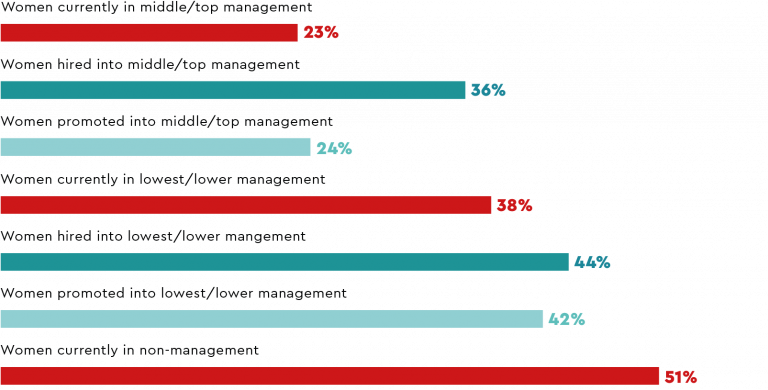In the Consulting industry, regarding gender, non-management is particularly well-balanced. However, when looking at top management, less than 20% of positions are held by women. This gap immediately starts (when looking at lowest management level), then grows. At lowest and lower management levels, around 38% of the positions are held by women. Lower in the pipeline, efforts at getting more women to the top seem to bear fruit. However, in middle management, only 30% of employees are female, and only 17% in top management. Overall, there is still much equitable work for organizations to be done.
The Consulting industry is not utilizing its diverse pipeline for internal development. The talent pool of 51% women in non-management is not reflected in the lowest and lower management promotion rate of 42%. Likewise, though there is 38% of women in lowest and lower management, women make up only 24% in middle and top management promotions.
Conversely, external recruitment significantly increases the share of women in middle and top management – 36% of new hires at this level are women. In fact, the share of women newly hired is higher than the share of female promotions for both lowest and lower as well as middle and top management. This tendency is more pronounced in consulting than in any other industry.
These trends point to an “up or out” mentality that puts women at a disadvantage, particularly at the higher management levels, so they tend to leave their companies to advance their careers.

When it comes to recruitment, an interesting trend persists for both men and women: New management hires have considerably higher shares of non-Swiss nationals than in the existing management population. This points to a growing internationalization in consulting, which further necessitates inclusive leadership and management as employees become more and more diverse.
Promotion rates indicate the persistence of traditional career models. Over 60% of all management promotions go to employees between 31 and 40, and it is precisely in this age category that the difference between men’s and women’s promotion rates is greatest – women only make up less than a quarter of promotions in this age group. This is even more pronounced for middle and top management promotions in the same age category. Less than one in five promotions in middle and top management goes to a woman, and three-quarters of all middle and top management promotions go to employees between 31 and 40. Compared to all other industries, the typical talent is particularly homogeneous (male, between 31 and 40, working full-time and has a tertiary degree).
Promotions and hiring patterns suggest that the traditional mindset in Consulting regarding career and gender roles persists. Yet, compared to other industries, the average employment percentages of women stay relatively constant across management levels – a slightly lower employment percentage in top positions might almost be considered a privilege deserved after working full-time all the way through the ranks.
The “up or out” mentality in consulting seems to affect women more than men, particularly in the “rush hours of life.” How can consulting companies better implement good practices with regard to sustainable talent management? The focus should be: Everyone is a talent.